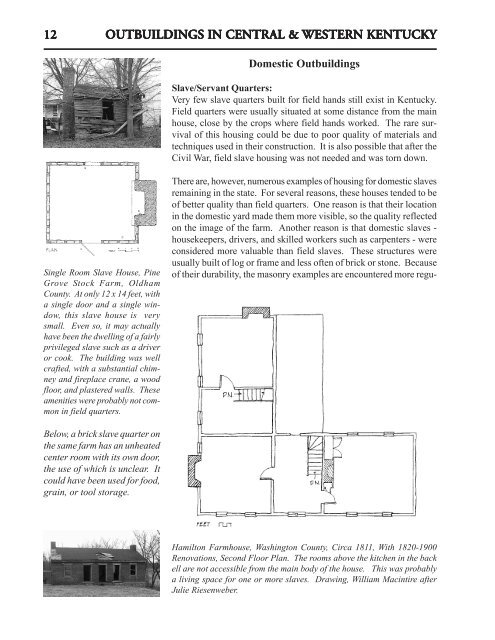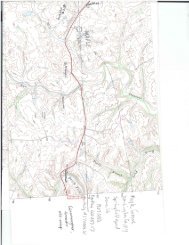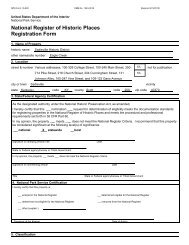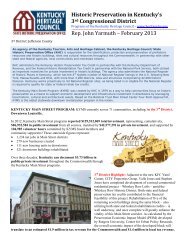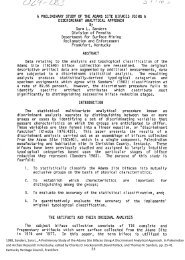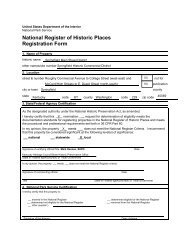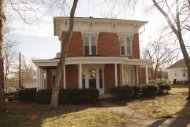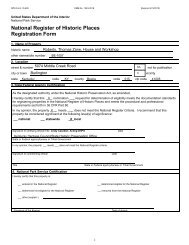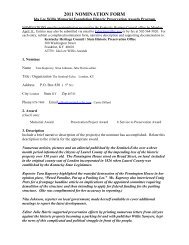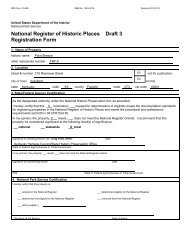Agricultural and Domestic Outbuildings in Central and Western
Agricultural and Domestic Outbuildings in Central and Western
Agricultural and Domestic Outbuildings in Central and Western
Create successful ePaper yourself
Turn your PDF publications into a flip-book with our unique Google optimized e-Paper software.
12<br />
12<br />
S<strong>in</strong>gle Room Slave House, P<strong>in</strong>e<br />
Grove Stock Farm, Oldham<br />
County. At only 12 x 14 feet, with<br />
a s<strong>in</strong>gle door <strong>and</strong> a s<strong>in</strong>gle w<strong>in</strong>dow,<br />
this slave house is very<br />
small. Even so, it may actually<br />
have been the dwell<strong>in</strong>g of a fairly<br />
privileged slave such as a driver<br />
or cook. The build<strong>in</strong>g was well<br />
crafted, with a substantial chimney<br />
<strong>and</strong> fireplace crane, a wood<br />
floor, <strong>and</strong> plastered walls. These<br />
amenities were probably not common<br />
<strong>in</strong> field quarters.<br />
Below, a brick slave quarter on<br />
the same farm has an unheated<br />
center room with its own door,<br />
the use of which is unclear. It<br />
could have been used for food,<br />
gra<strong>in</strong>, or tool storage.<br />
OUTB OUTBUILDINGS OUTB OUTB UILDINGS IN IN CENTRAL CENTRAL & & WESTERN WESTERN WESTERN KENTUCKY<br />
KENTUCKY<br />
KENTUCKY<br />
<strong>Domestic</strong> <strong>Outbuild<strong>in</strong>gs</strong><br />
Slave/Servant Quarters:<br />
Very few slave quarters built for field h<strong>and</strong>s still exist <strong>in</strong> Kentucky.<br />
Field quarters were usually situated at some distance from the ma<strong>in</strong><br />
house, close by the crops where field h<strong>and</strong>s worked. The rare survival<br />
of this hous<strong>in</strong>g could be due to poor quality of materials <strong>and</strong><br />
techniques used <strong>in</strong> their construction. It is also possible that after the<br />
Civil War, field slave hous<strong>in</strong>g was not needed <strong>and</strong> was torn down.<br />
There are, however, numerous examples of hous<strong>in</strong>g for domestic slaves<br />
rema<strong>in</strong><strong>in</strong>g <strong>in</strong> the state. For several reasons, these houses tended to be<br />
of better quality than field quarters. One reason is that their location<br />
<strong>in</strong> the domestic yard made them more visible, so the quality reflected<br />
on the image of the farm. Another reason is that domestic slaves -<br />
housekeepers, drivers, <strong>and</strong> skilled workers such as carpenters - were<br />
considered more valuable than field slaves. These structures were<br />
usually built of log or frame <strong>and</strong> less often of brick or stone. Because<br />
of their durability, the masonry examples are encountered more regu-<br />
Hamilton Farmhouse, Wash<strong>in</strong>gton County, Circa 1811, With 1820-1900<br />
Renovations, Second Floor Plan. The rooms above the kitchen <strong>in</strong> the back<br />
ell are not accessible from the ma<strong>in</strong> body of the house. This was probably<br />
a liv<strong>in</strong>g space for one or more slaves. Draw<strong>in</strong>g, William Mac<strong>in</strong>tire after<br />
Julie Riesenweber.


